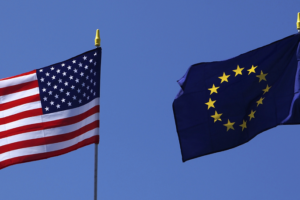Potential to eliminate duties between US and EU discussed in Brussels.

During his overseas trip in March, the President made several stops, including one in Brussels to consult with leaders of the European Union on creating a trading block.
The Trans Atlantic Trade and Investment Partnership, if enacted, would open both markets to each other products, but there are still some serious hurdles to overcome.
Both entities are very protective of their agricultural industries, whether in animals, plants, prepared foods or even wines and spirits.
If enacted, it represents a potential $100 billion annually in benefits for both sides.
There is still work to be done, though. US autos bound for the EU encounter a ten percent duty; EU vehicles coming the other way are only two percent.
Other products don’t even see the other region’s marketplace. For instance, there is presently near zero opportunity for US poultry bound going to the EU and American farmers also face tremendous hurdles because of opposition to GMO crops that are raised and harvested in the United States as well.
Like all free trade agreements, this one will come with its own particular requirements, especially over origin rules.
With each free trade agreement that the US signs, whether a bilateral (between two countries) or a regional (a group of countries) agreement, there is a strict set of rules governing what allows the goods to claim preferential duty status (either reduced or free).
At Brauner, we pay attention to the unique origin rules for each of these and advise our clients early in their product or purchasing cycle to prevent a surprise when the goods arrive at the border to be imported.
